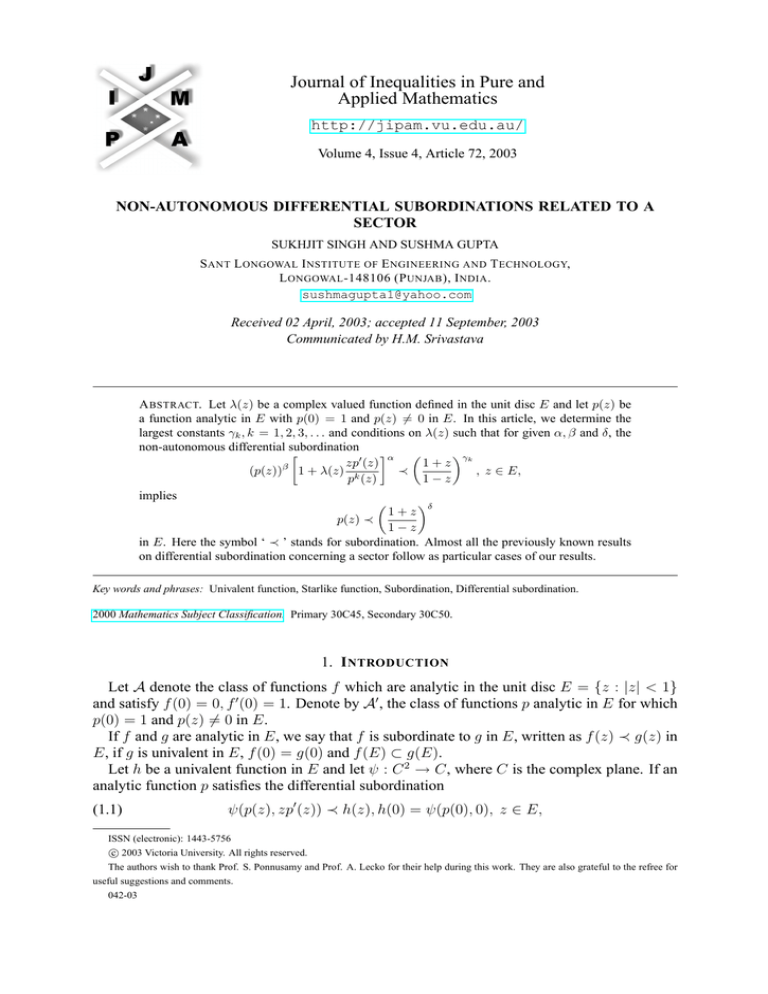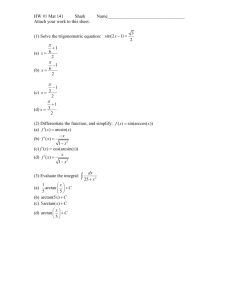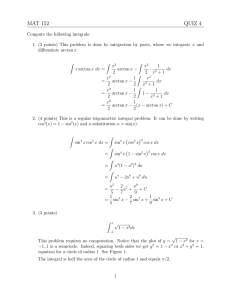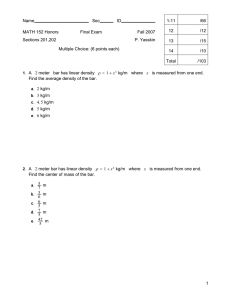
Journal of Inequalities in Pure and
Applied Mathematics
http://jipam.vu.edu.au/
Volume 4, Issue 4, Article 72, 2003
NON-AUTONOMOUS DIFFERENTIAL SUBORDINATIONS RELATED TO A
SECTOR
SUKHJIT SINGH AND SUSHMA GUPTA
S ANT L ONGOWAL I NSTITUTE OF E NGINEERING AND T ECHNOLOGY,
L ONGOWAL -148106 (P UNJAB ), I NDIA .
sushmagupta1@yahoo.com
Received 02 April, 2003; accepted 11 September, 2003
Communicated by H.M. Srivastava
A BSTRACT. Let λ(z) be a complex valued function defined in the unit disc E and let p(z) be
a function analytic in E with p(0) = 1 and p(z) 6= 0 in E. In this article, we determine the
largest constants γk , k = 1, 2, 3, . . . and conditions on λ(z) such that for given α, β and δ, the
non-autonomous differential subordination
α γ
1+z k
zp0 (z)
β
≺
, z ∈ E,
(p(z)) 1 + λ(z) k
p (z)
1−z
implies
δ
1+z
p(z) ≺
1−z
in E. Here the symbol ‘ ≺ ’ stands for subordination. Almost all the previously known results
on differential subordination concerning a sector follow as particular cases of our results.
Key words and phrases: Univalent function, Starlike function, Subordination, Differential subordination.
2000 Mathematics Subject Classification. Primary 30C45, Secondary 30C50.
1. I NTRODUCTION
Let A denote the class of functions f which are analytic in the unit disc E = {z : |z| < 1}
and satisfy f (0) = 0, f 0 (0) = 1. Denote by A0 , the class of functions p analytic in E for which
p(0) = 1 and p(z) 6= 0 in E.
If f and g are analytic in E, we say that f is subordinate to g in E, written as f (z) ≺ g(z) in
E, if g is univalent in E, f (0) = g(0) and f (E) ⊂ g(E).
Let h be a univalent function in E and let ψ : C 2 → C, where C is the complex plane. If an
analytic function p satisfies the differential subordination
(1.1)
ψ(p(z), zp0 (z)) ≺ h(z), h(0) = ψ(p(0), 0), z ∈ E,
ISSN (electronic): 1443-5756
c 2003 Victoria University. All rights reserved.
The authors wish to thank Prof. S. Ponnusamy and Prof. A. Lecko for their help during this work. They are also grateful to the refree for
useful suggestions and comments.
042-03
2
S UKHJIT S INGH
AND
S USHMA G UPTA
then a univalent function q is said to be the dominant of the differential subordination (1.1), if
p(0) = q(0) and p ≺ q for all p satisfying (1.1). Differential subordination (1.1) is said to be
non-autonomous if a function of z is allowed to be present on the left hand side, in addition to
the terms p(z) and zp0 (z).
Since 1981, when a formal study of differential subordination started with a remarkable paper
of Miller and Mocanu [5], several results concerning differential subordination in a sector have
been proved (e.g. see [6], [9] and [3]).
In the present paper, we establish the following two theorems.
Theorem 1.1. Let α ∈ [0, 1] be fixed and let δ ∈ (0, δ0 ], where δ0 is the solution of the equation
π
βδπ = 2π − α
+ arctanη
2
for β ≥ 0 and for a suitable fixed η > 0 such that λ(z) : E → C satisfies
(1.2)
δ Re λ(z)
≥ η, z ∈ E.
1 + δ|Imλ(z)|
If p ∈ A0 satisfies the non-autonomous differential subordination
α γ
zp0 (z)
1+z 1
β
(1.3)
(p(z)) 1 + λ(z)
≺
, z ∈ E,
p(z)
1−z
then,
p(z) ≺
1+z
1−z
δ
in E,
where,
2α
arctan η, 0 < δ ≤ δ0 .
π
1
Theorem 1.2. Let k = 2, 3, 4, . . . , α ∈ [0, 1], δ ∈ 0, k−1
be fixed. Also let β ≥ 0 be such that
0 ≤ βδ ≤ 2. For a suitable fixed η > 0, let λ(z) : E → C be a function satisfying
(1.4)
(1.5)
γ1 = βδ +
δ|λ(z)| cos ψ
≥ η, z ∈ E,
x + δ|λ(z)|| sin ψ|
where,
(1.6)
|ψ − Argλ(z)| = (k − 1)
δπ
2
and,
(1.7)
x = (1 − (k − 1)δ)
1−(k−1)δ
2
(1 + (k − 1)δ)
1+(k−1)δ
2
.
If p ∈ A0 satisfies the non-autonomous differential subordination
α γ
zp0 (z)
1+z k
β
≺
, z ∈ E,
(1.8)
(p(z)) 1 + λ(z) k
p (z)
1−z
then,
p(z) ≺
1+z
1−z
δ
in E,
where,
(1.9)
J. Inequal. Pure and Appl. Math., 4(4) Art. 72, 2003
γk = βδ +
2α
arctan η.
π
http://jipam.vu.edu.au/
N ON - AUTONOMOUS D IFFERENTIAL S UBORDINATIONS R ELATED TO A S ECTOR
3
We claim that our results unify most of the previously known results related to differential
subordinations in a sector. Some special cases of Theorem 1.1 and Theorem 1.2 have been
discussed in Section 3. In Section 4, we give some applications of our results to the univalent
functions.
We shall need the following lemma to prove our results.
Lemma 1.3. Let F be analytic in E and let G be analytic and univalent in E except for points
ζ such that limz→ζ F (z) = ∞, with F (0) = G(0). If F 6≺ G in E, then there exist points
z0 ∈ E, ζ0 ∈ ∂E (boundary of E) and an m ≥ 1 for which
(a) F (|z| < |z0 |) ⊂ G(E),
(b) F (z0 ) = G(ζ0 ) and
(c) z0 F 0 (z0 ) = mζ0 G0 (ζ0 ).
Lemma 1.3 is due to Miller and Mocanu [5].
2. P ROOFS OF M AIN T HEOREMS
1+z δ
Proof of Theorem 1.1. Let q(z) = 1−z
. Then we need to prove that (1.3) implies p(z) ≺
q(z) in E. Suppose, on the contrary, that p 6≺ q in E. Then, by Lemma 1.3, there exist
points z0 ∈ E, ζ0 ∈ ∂E and an m ≥ 1 such that p(z0 ) = q(ζ0 ) and z0 p0 (z0 ) = mζ0 q 0 (ζ0 ).
0
Since p(z0 ) = q(ζ0 ) 6= 0, it follows that ζ0 6= ±1. Thus 1+ζ
= ri for r 6= 0. Writing
1−ζ0
iφ
λ(z0 ) = Re , |φ| < π/2, a simple calculation gives
α
α
z0 p0 (z0 )
mζ0 q 0 (ζ0 )
β
β
(p(z0 )) 1 + λ(z0 )
= (q(ζ0 )) 1 + λ(z0 )
p(z0 )
q(ζ0 )
2
α
iφ
imδRe
r +1
βδ
= (ri)
1+
2
r
= Ψ0 say.
Then,
(2.1)
βδπ
ArgΨ0 = ±
+ α arctan
2
"
#
mδRcosφ
.
2r
− mδRsinφ
r 2 +1
Here a positive sign corresponds to r > 0 and a negative sign to r < 0.
mδR cos φ
, where x(r) = r22r+1 . Then, Max|x(r)| = 1 for all values of
Let A = A(m, r) = x(r)−mδR
sin φ
r whether positive or negative.
If we define,
mδRcosφ
B = B(m, r) =
,
|x(r)| + mδR|sinφ|
then B is an increasing function of m for each fixed r, and therefore, for m ≥ 1, we have
δRcosφ
δRcosφ
B≥
≥
≥ η, (using (1.2)).
|x(r)| + δR|sinφ|
1 + δR|sinφ|
Now, It is easy to check the following six cases:
(i) When r > 0 and sinφ ≤ 0, we have A = B.
(ii) When r > 0 and x(r) > mδRsinφ > 0, we get A > B.
(iii) When r > 0 and x(r) < mδRsinφ, we get A < −B.
(iv) When r < 0 and sinφ ≥ 0, we have A = −B.
(v) When r < 0 and mδRsinφ < −|x(r)|, we have A > B.
(vi) When r < 0 and 0 > mδRsinφ > −|x(r)|, we get A < −B.
J. Inequal. Pure and Appl. Math., 4(4) Art. 72, 2003
http://jipam.vu.edu.au/
4
S UKHJIT S INGH
AND
S USHMA G UPTA
Since arctan is an increasing function of its argument, therefore, in view of cases (i) and (ii),
we get from (2.1),
βδπ
ArgΨ0 ≥
+ α arctanB
2
βδπ
≥
+ α arctan η
2
γ1 π
=
.
2
For the case (iii), we get
βδπ
+ α arctan(−B)
ArgΨ0 <
2
βδπ
≤
− α arctan η
2
γ1 π
= βδπ −
2
γ1 π
≤ 2π −
, since 0 ≤ βδ ≤ βδ0 < 2.
2
For cases (iv) and (vi), we get
βδπ
ArgΨ0 ≤ −
+ α arctan(−B)
2
βδπ
≤−
− α arctan η
2
γ1 π
=−
.
2
In case (v), we have
βδπ
ArgΨ0 > −
+ α arctanB
2
βδπ
≥−
+ α arctan η
2
γ1 π = − βδπ −
2
γ1 π ≥ − 2π −
, since 0 ≤ βδ ≤ βδ0 < 2.
2
Combining all the above cases, we obtain
γ1 π
γ1 π
≤ | Arg Ψ0 | ≤ 2π −
,
2
2
δ
which is a contradiction to (1.3). Hence p(z) ≺ 1+z
. The proof of the theorem is complete.
1−z
Proof of Theorem 1.2. Proceeding as in the proof of Theorem 1.1, we get
α
α
z0 p0 (z0 )
imδR 2
β
βδ
−1−(k−1)δ i(φ−(k−1)δπ/2)
(p(z0 )) 1 + λ(z0 ) k
= (ri)
1+
(r + 1)r
e
p (z0 )
2
= Θ0 say.
, then we get
Now, if ψ − φ = −(k − 1) δπ
2
(2.2)
βδπ
Arg Θ0 =
+ α arctan
2
J. Inequal. Pure and Appl. Math., 4(4) Art. 72, 2003
"
mδRcosψ
2r 1+(k−1)δ
r2 +1
− mδRsinψ
#
.
http://jipam.vu.edu.au/
N ON - AUTONOMOUS D IFFERENTIAL S UBORDINATIONS R ELATED TO A S ECTOR
5
i
h
1+(k−1)δ
mδRcosψ
, where x(r) = 2r r2 +1 . Since (k − 1)δ < 1, it is easy to
Let A = A(m, r) = x(r)−mδRsinψ
verify that for r > 0 (and, of course, also for r < 0),
max |x(r)| = (1 − (k − 1)δ)
1−(k−1)δ
2
(1 + (k − 1)δ)
1+(k−1)δ
2
= x, using (1.7).
Now, if we define,
B = B(m, r) =
mδRcosψ
,
|x(r)| + mδR|sinψ|
then, B is an increasing function of m and, therefore, for m ≥ 1, we have
B≥
δRcosψ
δRcosψ
≥
≥ η, using (1.5).
|x(r)| + δR|sinψ|
x + δR|sinψ|
Now, one can easily verify the following three cases:
Case (i). A = B, when sinψ ≤ 0.
Case(ii). A > B, when sinψ > 0 and x(r) > mδRsinψ.
Case (iii). A < −B, when sinψ > 0 and x(r) < mδRsinψ.
Since arctan is an increasing function of its argument, therefore, in view of cases (i) and (ii),
we get from (2.2)
βδπ
+ α arctan η
2
γk π
=
, using (1.9).
2
ArgΘ0 ≥
For the case (iii), we obtain
βδπ
+ α arctan(−B)
2
βδπ
≤
− α arctan η
2
γk π
≤ βδπ −
2
γk π
≤ 2π −
, since βδ ≤ 2.
2
Now, consider the case when r < 0. Writing r = −a, a > 0 we have
α
α
z0 p0 (z0 )
imδR (a2 + 1)ei(φ+(k−1)δπ/2)
β
βδ −iβδπ
(p(z0 )) 1 + λ(z0 ) k
=a e 2
1−
p (z0 )
2
a1+(k−1)δ
= Φ0 say.
ArgΘ0 <
If ψ − φ = (k − 1) δπ
, then
2
ArgΦ0 =
−βδπ
+ α arctan C,
2
mδRcosψ
.
where C = C(m, r) = −|x(r)|−mδRsinψ
It is now elementary to check the following three cases:
Case (a). When sinψ ≥ 0, we have C = −B.
Case (b). When sinψ < 0 and mδR sinψ < −|x(r)|, we obtain C > B.
Case (c). For sinψ < 0 and mδRsinψ > −|x(r)|, we have C < −B.
J. Inequal. Pure and Appl. Math., 4(4) Art. 72, 2003
http://jipam.vu.edu.au/
6
S UKHJIT S INGH
AND
S USHMA G UPTA
For cases (a) and (c), we get
−βδπ
+ α arctan(−B)
2
−βδπ
≤
− α arctan η
2
γk π
.
=−
2
ArgΦ0 ≤
In case (b), we have
−βδπ
+ α arctan B
2
−βδπ
≥
+ α arctan η
2
γk π
= −(βδπ −
)
2
γk π
≥ −(2π −
), since βδ ≤ 2.
2
Combining the above six cases, three for r > 0 and three for r < 0, we have
α γk π z0 p0 (z0 )
β
≤ 2π − γk π ,
≤ Arg (p(z0 )) 1 + λ(z0 ) k
2
p (z0 )
2
δ
which is a contradiction to (1.8). Hence p(z) ≺ 1+z
. This completes the proof.
1−z
ArgΦ0 >
3. S PECIAL C ASES
(i) Taking α = β = 1 in Theorem 1.1, we get the result of S. Ponnusamy [9, p. 399,
Lemma 1].
(ii) Setting α = β = 1 and λ(z) = λ, a positive real number, in Theorem 1.1, we get
Theorem 5 of Miller and Mocanu [6, p. 532].
(iii) Putting β = 1 and λ(z) = 1 in Theorem 1.1, we get the result of A. Lecko et.al. [4, p.
198, Theorem 2.1].
(iv) In Theorem 1.1, taking α = 1, we get the following result:
Let β ≥ 0 and let δ0 be the solution of the equation
3π
βδπ =
− arctan η,
2
for a suitable fixed η > 0 such that λ(z) : E → C is a function satisfying
δ Re λ(z)
≥ η, z ∈ E.
1 + δ| Im λ(z)|
If p ∈ A0 satisfies the non-autonomous differential subordination
γ
1+z
β
β−1
0
p (z) + λ(z)p (z)zp (z) ≺
, z ∈ E,
1−z
then,
p(z) ≺
1+z
1−z
δ
in E,
where,
γ = βδ +
J. Inequal. Pure and Appl. Math., 4(4) Art. 72, 2003
2
arctan η, 0 < δ ≤ δ0 .
π
http://jipam.vu.edu.au/
N ON - AUTONOMOUS D IFFERENTIAL S UBORDINATIONS R ELATED TO A S ECTOR
7
(v) In Theorem 1.2, taking λ(z) = 1 and β = 1, we get the result of A. Lecko [3, p. 344,
Theorem 2.1].
(vi) Putting α = β = 1 and k = 2 in Theorem 1.2, we obtain the following result:
For 0 < δ < 1 and η > 0, let λ(z) : E → C be a function satisfying
δ|λ(z)|cosψ
≥ η, z ∈ E,
x + δ|λ(z)||sinψ|
where |ψ − Argλ(z)| =
If p ∈ A0 satisfies,
δπ
2
and x = (1 + δ)
zp0 (z)
p(z) + λ(z)
≺
p(z)
1+δ
2
(1 − δ)
1+z
1−z
1−δ
2
.
γ 2
in E, then,
p(z) ≺
1+z
1−z
δ
in E, where γ2 = δ + π2 arctan η.
Taking λ(z) = λ, a positive real number in the above result, we get the well-known
differential subordination (see [7, p. 268, 5.1-40]).
0 (z)
(vii) Taking β + α in place of β, λ(z) = 1, k = 2 and p(z) = zff (z)
, where f ∈ A, in
Theorem 1.2, we get the following (Also see Darus and Thomas [2, p. 1050, Theorem
1]):
Let α ∈ [0, 1], δ ∈ (0, 1) and β ≥ 0 be such that 0 ≤ (β + α)δ ≤ 2. If f ∈ A satisfies
0 β α γ
zf (z)
zf 00 (z)
1+z 2
1+ 0
≺
,
f (z)
f (z)
1−z
then,
δ
1+z
zf 0 (z)
≺
in E,
f (z)
1−z
where,
#
"
2α
δπ
δ
.
γ2 = βδ +
arctan tan
+
1+δ
1−δ
π
2
(1 + δ) 2 (1 − δ) 2 cos δπ
2
0
(viii) Writing β = 1, α = 1, λ(z) = 1, k = 2 and p(z) = zf (z)/f (z), where f ∈ A, in
Theorem 1.2, we get well-known result of Nunokawa and Thomas [8, p. 364, Theorem1].
4. A PPLICATIONS TO U NIVALENT F UNCTIONS
In this section, we give some applications of our results to univalent functions and obtain
some new conditions for univalence, starlikeness and strongly starlikeness.
A function f ∈ A is said to be strongly starlike of order α, 0 < α ≤ 1, if
0
απ
zf
(z)
arg
<
in E.
f (z) 2
We denote the set of all such functions by S ∗ (α). The class S ∗ (α) was introduced and studied
independently by Brannan and Kirwan [1] and Stankiewicz [10]. Note that S ∗ (1) is the usual
class of starlike functions f in A satisfying
0 zf (z)
Re
> 0, z ∈ E.
f (z)
J. Inequal. Pure and Appl. Math., 4(4) Art. 72, 2003
http://jipam.vu.edu.au/
8
S UKHJIT S INGH
AND
S USHMA G UPTA
We denote this class by St.
First of all, we note that if f ∈ A, then the functionals
of the class A0 .
f (z)
, f 0 (z)
z
and
zf 0 (z)
f (z)
are all members
Theorem 4.1. Let α ∈ [0, 1] and let δ0 = 0.6165 . . . be the unique root of the equation
2 arctan(1 − δ) + π(1 − 2δ) = 0.
(4.1)
Further, let β ≥ 0 be such that βδ ≤ βδ0 ≤ 2 for 0 < δ ≤ δ0 . If a function f ∈ A,
f 0 (z) 6= 0, z ∈ E, satisfies
α γ
1+z
zf 00 (z)
0
β
≺
, z ∈ E,
(4.2)
(f (z)) 1 + 0
f (z)
1−z
then f ∈ St where γ = βδ +
2α
arctan
π
δ.
Proof. In Theorem 1.1, taking λ(z) = 1 and p(z) = f 0 (z), the subordination (4.2) implies
δ
1+z
0
, z ∈ E,
(4.3)
f (z) ≺
1−z
where γ = βδ + 2α
arctan δ. Again using Theorem 1.1 with α = β = λ(z) = 1 and p(z) =
π
we get from (4.3),
µ
f (z)
1+z
≺
, z ∈ E,
z
1−z
2
π
arctanµ which is equivalent to (4.1) with µ = 1 − δ. Now
zf 0 (z) f (z) 0
arg
≤ |argf (z)| + arg
f (z) z π
π
≤ (δ + µ) = ,
2
2
and the desired result follows.
where δ = µ +
f (z)
,
z
Writing p(z) =
f (z)
z
and λ(z) = 1 in Theorem 1.1, we get:
Lemma 4.2. Let α ∈ [0, 1]be fixed and let δ ∈ (0, δ0 ], where δ0 is the solution of the equation
π
βδπ = 2π − α
+ arctan δ
2
for fixed β ≥ 0. If f ∈ A,
f (z)
z
6= 0, z ∈ E, satisfies
β−α
γ
f (z)
1+z
0
α
(f (z)) ≺
in E,
z
1−z
then,
f (z)
≺
z
where γ = βδ +
2α
π
1+z
1−z
δ
, z ∈ E,
arctan δ.
Theorem 4.3. Let α ∈ [0, 1], β ≥ 0 be fixed. Suppose that γ0 , α/2 < γ0 ≤ α, is the unique
root of the equation
2γ − α π
(4.4)
β = (α − γ)cot
.
α
2
J. Inequal. Pure and Appl. Math., 4(4) Art. 72, 2003
http://jipam.vu.edu.au/
N ON - AUTONOMOUS D IFFERENTIAL S UBORDINATIONS R ELATED TO A S ECTOR
Let f ∈ A,
f (z)
z
(4.5)
9
6= 0, z ∈ E, satisfy
β−α
γ
f (z)
1+z
0
α
(f (z)) ≺
in E.
z
1−z
Then f ∈ St.
Proof. In view of (4.5) and Lemma 4.2, we have
δ
f (z)
1+z
≺
, z ∈ E,
z
1−z
where δ is given by the equation
2α
arctan δ.
π
We observe that (4.6) is equivalent to (4.4) with δβ = α − γ. Now
β−α β zf 0 (z) f
(z)
f
(z)
≤ arg(f 0 (z))α
α arg
+ arg
f (z)
z
z
γ = βδ +
(4.6)
≤
γπ βδπ
απ
+
=
,
2
2
2
and the conclusion follows.
Remark 4.4. Taking α = 1 in Theorem 4.3, we get the Theorem 1 of Ponnusamy [9, p. 403].
Taking α = β =
1
2
in Theorem 4.3, we get
Example 4.1. For f ∈ A, the differential subordination
γ
p
1
+
z
in E,
f 0 (z) ≺
1−z
implies that f is starlike in E where γ = 0.3082 . . . is given by 2 arctan (1−2γ)+π(1−4γ) = 0.
Setting p(z) = f 0 (z) and α = λ(z) = 1 in Theorem 1.1, we obtain
Corollary 4.5. For β ≥ 0, if an analytic function f in A satisfies
2β+1
2
1+z
0
β
0
β−1
00
(f (z)) + (f (z)) zf (z) ≺
in E,
1−z
then
f 0 (z) ≺
1+z
in E,
1−z
and, hence, f is univalent in E.
Writing p(z) =
result:
zf 0 (z)
,
f (z)
k = 2 and (β + α) in place of β in Theorem 1.2, we get the following
Theorem 4.6. Let α ∈ [0, 1] and β ≥ 0 be fixed. Let δ ∈ (0, 1) be such that 0 ≤ (β + α)δ ≤ 2.
For a fixed η > 0, let λ(z) : E → C be a function satisfying
δ|λ(z)|cosψ
≥ η, z ∈ E,
x + δ|λ(z)||sinψ|
where |ψ − Arg λ(z)| =
δπ
2
and x = (1 + δ)
J. Inequal. Pure and Appl. Math., 4(4) Art. 72, 2003
1+δ
2
(1 − δ)
1−δ
2
.
http://jipam.vu.edu.au/
10
S UKHJIT S INGH AND S USHMA G UPTA
If f ∈ A satisfies the differential subordination
0 β α γ
zf (z)
1+z 2
zf 0 (z)
zf 00 (z)
(1 − λ(z))
+ λ(z) 1 + 0
≺
f (z)
f (z)
f (z)
1−z
in E, then
δ
zf 0 (z)
1+z
≺
f (z)
1−z
∗
in E i.e. f ∈ S (δ) in E, where γ2 = (β + α)δ + 2α
arctan η.
π
Taking β = 0, α = 1, λ(z) = λ, λ real, in Theorem 4.6, we obtain the well-known result [7,
p. 266, Cor. 5. 1i. 1].
R EFERENCES
[1] D.A. BRANNAN AND W.E. KIRWAN, On some classes of bounded univalent functions, J. London
Math. Soc., 1(2) (1969), 431–443.
[2] M. DARUS AND D.K. THOMAS, α-logarithmically convex functions, Indian J. Pure Appl. Math.,
29(10) (1998), 1049–1059.
[3] A. LECKO, On differential subordinations connected with convex functions related to a sector,
Kyungpook Math. J., 39 (1999), 343–350.
[4] A. LECKO, M. LECKO, M. NUNOKAWA AND S. OWA, Differential subordinations and convex
functions related to a sector, Mathematica, 40(63)(2) (1998), 197–205.
[5] S.S. MILLER AND P.T. MOCANU, Differential subordinations and univalent functions, Michigan
Math. J., 28 (1981), 157–171.
[6] S.S. MILLER AND P.T. MOCANU, Marx- Strohhäcker differential subordination systems, Proc.
Amer. Math. Soc., 99(3) (1987), 527–534.
[7] S.S. MILLER AND P.T. MOCANU, Differential Subordinations-Theory and Applications, Marcel
Dekker Inc., New York, Basel.
[8] M. NUNOKAWA AND D.K. THOMAS, On convex and starlike functions in a sector, J. Austral.
Math. Soc. (series A), 60 (1996), 363–368.
[9] S. PONNUSAMY, Differential subordinations concerning starlike functions, Proc. Indian Acad.
Sci. (Math. Sci.), 104(2) (1994), 397–411.
[10] J. STANKIEWICZ, Some remarks concerning starlike functions, Bull. Acad. Polon. Sci. Ser. Sci.
Math. Astronom. Phy., 18 (1970), 143–146.
J. Inequal. Pure and Appl. Math., 4(4) Art. 72, 2003
http://jipam.vu.edu.au/






